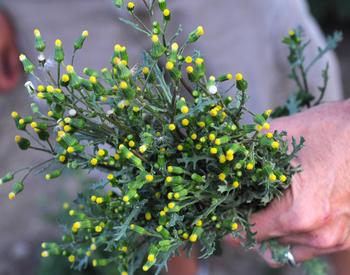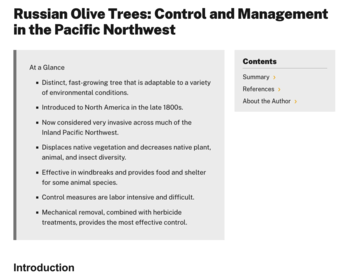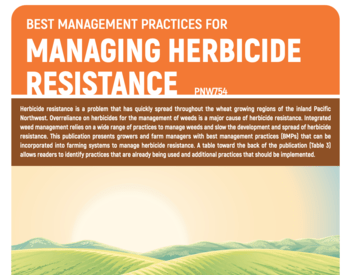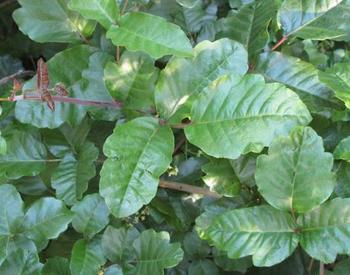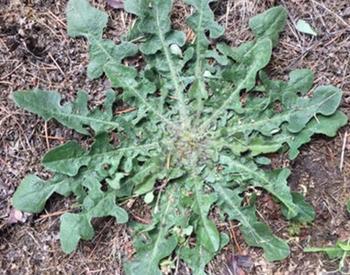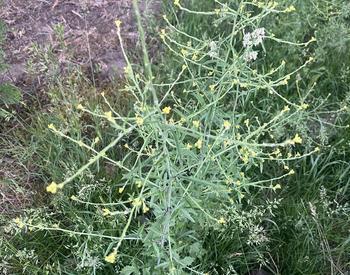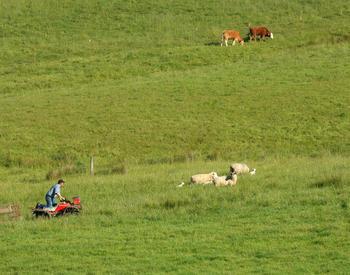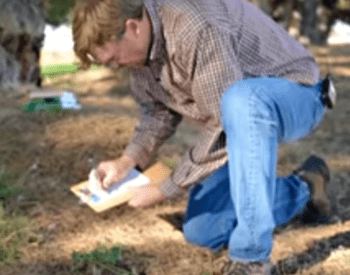Tansy ragwort, a biennial weed in the sunflower family, has made a big comeback in parts of western Oregon, especially in the foothills where livestock grazing is prevalent.
Tansy ragwort was unintentionally introduced into Oregon in the early 1920s, and within 30 years, became a regional problem, killing thousands of livestock animals — mostly cattle and horses, and contaminating pastures and hay. By the 1970s, many pastures, hillsides, and log clearings were invaded and heavily infested by tansy ragwort. Tansy is mostly a weed that gets a foothold in plant communities that have been disturbed, either by grazing, logging, construction or fire.
Oregon in the mid-1980s through 2005 effectively controlled tansy ragwort around, bringing $5 million a year in economic benefits to Oregon agriculture. The Oregon legislature commissioned the Oregon Department of Agriculture to implement a biological control program for the weed, and three insects — the cinnabar moth, a flea beetle, and a seed head fly — were introduced from 1960-1971. These insects are natural enemies of tansy ragwort and were tested for host specificity and imported from tansy’s homeland in Western Europe. Once they were established in Oregon, the state agriculture department began an intensive redistribution program, collecting and releasing millions of the biocontrol agents at infested sites throughout the state. By the mid-1980s, tansy infestations were in sharp decline and cattle deaths were reduced by more than 90%.
Tansy maintained a low profile until 2005, when a winter drought followed by a warm wet spring prompted a resurgence of the pernicious weed. Although tansy populations were low, so were the biocontrol agents, and the long, wet and cool spring seasons favored the week but hindered the insects. This boom-and-bust cycle is natural, and it takes several years for the insects to build up and recontrol the weed.
At some sites, livestock overgrazing encourages weed growth, but tansy ragwort also a problem at some ungrazed sites. For example, field mice and gophers can create microsites where the weed flourishes.
Biological control of Tansy Ragwort
Spraying or mowing tansy in full bloom, if done too late, allows seeds to form and ripen, making treatment a waste of time and money. The best time to spray is in the fall when new seedlings are in the rosette stage or in the spring before the plants bolt. Mowing can cause plants to perennate (become short-lived perennials), so the same plant grows back next year. For small or accessible infestations, these control options may work well.
The best option is to promote a healthy stand of grass. Avoid overgrazing. The biological control agents mostly weaken the weeds, which then succumb to the competition with other desirable plants.
At sites where field mice (Microtus species), gophers and moles cause a disturbance with their tunnel mounds and appetite for grasses, raptor perches and mowing the grass down to increase predation can help. Use of rodenticides has not been evaluated to control rodent-caused outbreaks.
We often hear “I used to have cinnabar moths, now I need more. What do I do now?” Biological control sites are usually reserved for large infestations and those in rough terrain where other controls are difficult or costly. Biocontrol agents were already at nearly every site we have checked and were beginning to build up their populations. This is better than if there were none, as it would take longer to reachieve control at those sites.
The insects were so widely redistributed, that it is very rare to find sites where they do not occur, especially in the Willamette Valley. If the insects are present, it may take several years for them to build up and control the weed. If the land manager cannot wait that long and attempt to reduce the grazing pressure on infested areas, then other control measures should be taken (see Additional Information and Advice below). Some land managers have fenced off the more infested parts to allow the insects to build up and control tansy ragwort. The insects can then disburse from those areas into nearby infestations.
Some landowners can use sheep, which are not susceptible to tansy ragwort poisoning, to precondition a pasture before allowing cattle in. The management threshold at which one should take action to control tansy is when it exceeds one plant per square yard, and covers more than a quarter of a pasture.
Landowners should check if they have the biological agents present at their infestations. The colorful red-and-black cinnabar moths can be seen flying around in May and June, and their inch-long black and orange-banded larvae in June–July, later at higher elevations or in years with a cool spring. The larvae defoliate the plants, and work best at large infestations. Heavily attacked plants are stripped of leaves and flowers. Some plants may regrow and produce late flowers, when enough moisture is present in the late summer.
The ragwort flea beetle is the workhorse of the tansy ragwort biocontrol program but fails to get credit because it is small and active in the fall during the rainy season. The eighth-inch adults are golden in color and hop like a flea when disturbed. When feeding, they leave BB-sized shot holes in the older leaves. Adult feeding on rosettes during the winter can actually kill smaller rosettes. The larvae feed in the root crown and often in the leaf stalks before they mature in the early summer and pupate in the soil litter. Sites where flea beetles were released achieved over 90% control within seven years.
The ragwort seed fly attacks developing flower heads, where a single larva in a seed head destroys most all of the seeds. The fly only attacks the early developing seed heads and rarely attacks more than 10-40% of the seed heads, thus it is the most ineffective biocontrol agent. Damage is noticed mostly by the frothy spittle that emanates from an attacked flower head.
If you are planning on or wanting to use biological control, the best thing to do is to reduce the pressure on the desirable flora and allow the plants and insects to go through their natural cycles undisturbed. This seems counterintuitive, but the insects need the plants to survive, and many sites which are mowed and sprayed often return with tansy, if grazing pressure is not reduced.
An important thing to do is to look around the area and see where tansy ragwort is not a problem, then try to replicate the management from those sites. Often we find the tansy is within a fence line, indicating the infestation is a representation from the past several years of management. The seeds of ragwort rarely are dispersed more than 10-30 feet from the parent plant. Most infestations arise from seeds stored in the soil bank, which can remain viable for over 10 years. In wet years, ragwort can increase 10 fold from the previous year. At most sites, biological control agents have reduced the infestations of tansy ragwort within a two year period.
Additional information and advice including herbicide options
The decision to manage tansy ragwort with the three biocontrol agents or through mechanical or chemical methods rests with each individual landowner. A combination of management strategies will likely result in the greatest long-term tansy ragwort management successes. Prevent livestock poisonings by ensuring that the susceptible livestock (especially cattle, pigs and horses) have enough high-quality forage and do not become so hungry that they start eating tansy ragwort. A lethal dose of tansy ragwort in horses and cows is from 7.3% to 3.6% of body weight, respectively. The toxin is pyrrolizidine alkaloid and accumulates in the liver as tansy is consumed. Never turn hungry livestock out into a pasture containing poisonous weeds. Prevent overgrazing and practice good pasture management.
Although grazing livestock do not usually eat live tansy plants, both mowing and herbicide applications wilt plants and make them more palatable to livestock. If you choose these two control practices, either physically remove the tansy plants or remove the livestock from the area. Tansy dried in hay retains its toxic properties. Do not hay a field with tansy or feed forage containing dried tansy to susceptible animals. For mowing to be a useful management practice, do it prior to seed maturity to decrease viable seed production. Mowing too early in the plant life cycle will allow time for the plant to bolt and flower again.
Apply herbicides in the fall after rains allow green-up of rosettes or for new seedlings to emerge or in the spring before plants bolt. Specific herbicide application timings and rates differ by the type of herbicide used and the growth stage of the target weed and forage crop. Herbicide labels may also differ by intended application site (pasture, right of way, forest, etc.). Follow grazing and haying restrictions and other instructions on the herbicide labels.
In the fall, mow off dead plant material and wait for rains to stimulate regrowth of rosettes or emergence of new seedlings. The most economical herbicide treatments would be products containing premixes of 2,4-D + dicamba. For high-density infestations of tansy, use the highest labeled rates of these types of products and review the grazing and haying restrictions on individual labels. Herbicides containing aminopyralid also work well on tansy ragwort, but will likely be more expensive. Always follow the recommendations on the labels of herbicides containing aminopyralid for managing forage, manure and compost. For specific herbicide application information use the PNW Weed Management Handbook (see the Control of Problem Weeds and Pasture and Rangeland Chapters)
Since mowing and spraying tansy may interfere with the effectiveness of biological control agents, consider leaving tansy plants as habitat and food for the biological controls if the weeds do not threaten livestock.
More information
Publications on tansy ragwort biology and control can be obtained through the OSU Extension Service Catalog:
- Invasive Weeds in Forestland: Tansy Ragwort (EC 1599-E)
For more information contact
